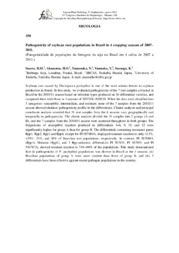Pathogenicity of soybean rust populations in Brazil 4 cropping seasons 2007 - 2011.
Pathogenicity of soybean rust populations in Brazil 4 cropping seasons 2007 - 2011.
Autoria: SOARES, R. M.; AKAMATSU, H. O.; YAMANAKA, N.; YAMAOKA, Y.; SUENAGA, K.
Resumo: Soybean rust caused by Phakopsora pachyrhizi is one of the most serious threats to soybean production in Brazil. In this study, we evaluated pathogenicity of the 7 rust samples collected in Brazil in the 2010/11 season based on infection types produced on 16 differential varieties, and compared them with those in 3 seasons of 2007/08?2009/10. When the data were classified into 3 categories: susceptible, intermediate, and resistant, none of the 7 samples from the 2010/11 season showed identical pathogenicity profile in the differentials. Cluster analysis and principal coordinate analysis revealed that 31 rust samples from the 4 seasons vary geographically and temporally in pathogenicity. The cluster analysis divided the 31 samples into 2 groups (A and B), and the 7 samples from the 2010/11 season were scattered throughout in both groups. The frequencies of susceptible reaction produced in differentials 3?6, 9, 10, and 12 were significantly higher for group A than for group B. The differentials containing resistance genes Rpp1, Rpp2, Rpp3 and Rpp4, except for PI 587880A, displayed resistant reaction to only <13%, <39%, 23%, and 38% of Brazilian rust populations, respectively. In contrast, PI 587880A (Rpp1), Shiranui (Rpp5), and 3 Rpp-unknown differentials PI 587855, PI 587905, and PI 594767A, showed resistant reaction to 74%?96% of the populations. This study demonstrated that (i) pathogenicity of P. pachyrhizi populations was diverse in Brazil in the 4 seasons, (ii) Brazilian populations of group A were more virulent than those of group B, and (iii) 5 differentials have been effective against recent pathogen populations in the country.
Ano de publicação: 2012
Tipo de publicação: Resumo em anais e proceedings
Unidade: Embrapa Soja
Palavras-chave: Fitopatologia
Observações
1 - Por padrão são exibidas publicações dos últimos 20 anos. Para encontrar publicações mais antigas, configure o filtro ano de publicação, colocando o ano a partir do qual você deseja encontrar publicações. O filtro está na coluna da esquerda na busca acima.
2 - Para ler algumas publicações da Embrapa (apenas as que estão em formato ePub), é necessário ter, no celular ou computador, um desses softwares gratuitos. Sistemas Android: Google Play Livros; IOS: iBooks; Windows e Linux: software Calibre.
Acesse outras publicações
Acesse a Base de Dados da Pesquisa Agropecuária (BDPA) para consultar o acervo completo das bibliotecas da Embrapa.

